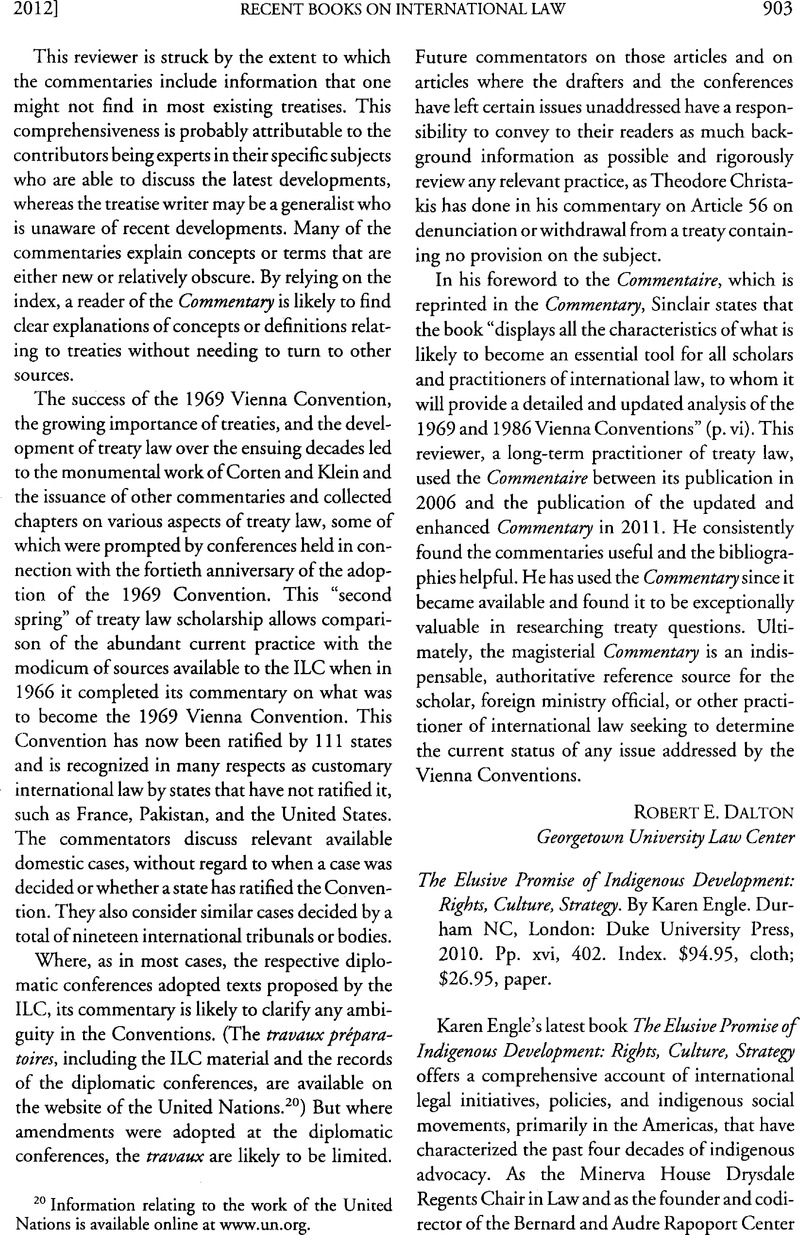No CrossRef data available.
Article contents
The Elusive Promise of Indigenous Development: Rights, Culture, Strategy. By Karen Engle. Durham NC, London: Duke University Press, 2010. Pp. xvi, 402. Index. $94.95, cloth; $26.95, paper.
Published online by Cambridge University Press: 20 January 2017
Abstract

- Type
- Recent Books on International Law
- Information
- Copyright
- Copyright © American Society of International Law 2012
References
1 David Kennedy, The Dark Sides of Virtue: Reassessing International Humanitarianism (2004).
2 E.g., Engle, Karen, Culture and Human Rights: The Asian Values Debate in Context, 32 N.Y.U. J. Int’l L. & Pol. 291 (2000)Google Scholar.
3 See, e.g., Engle, Karen, From Skepticism to Embrace: Human Rights and the American Anthropological Association from 1947-1999, 23 Hum. Rts. Q. 536 (2001)CrossRefGoogle Scholar (noting the changed attitude of the American Anthropological Association (Aaa) from its 1947 Statement on Human Rights—a critical document toward to the eventual Universal Declaration of Human Rights from 1948—to the Aaa’s 1999 Declaration, which showed clear alliance with the human rights discourse); American Anthropological Ass’n, Statement on Human Rights, 49 Am. Anthropologist 539 (1947)CrossRefGoogle Scholar; American Anthropological Ass’n Committee for Human Rights, Declaration on Anthropology and Human Rights (1999) [hereinafter 1999 Declaration], available at http://www.aaanet.org/stmts/humanrts.htm.
4 Spivak, Gayatri Chakravorty, Can the Subaltern Speak?, in Marxism and the Interpretation of Culture 271, 296-97 (Nelson, Cary & Grossberg, Lawrence eds., 1988)CrossRefGoogle Scholar.
5 Quoting Vine Deloria Jr., Behind the Trail of Broken Treaties: an Indian Declaration of Independence (1974).
6 Quoting Antony Anghie, Imperialism, Sovereignty and the Making of International Law 22 (2005).
7 Samuel Moyn, the Last Utopia: Human Rights in History (2010).
8 The triumph of human rights as well as this translation process is the topic of vast scholarship. E.g., Mila Halme-Tuomisaari, Human Rights in Action: Learning Expert Knowledge (2010).
9 Id. at 57-74.
10 Quoting Elizabeth A. Povinelli, The Cunning of Recognition: Indigenous Alterities and the Making of Australian Multiculturalism 12, 176 (2002). Engle adds that this “repugnant” language comes from the Australian High Court decision Mabo v. Queensland (No. 2) (1992) 175 Clr 1, para. 68 (Austl.).
11 As Engle demonstrates, behind assimilation policies were, of course, also other desires such as hopes to incorporate indigenous communities into economically productive parts of liberal societies.
12 1999 Declaration, supra note 3.
13 Aloeboetoe v. Suriname, Reparations and Costs, Inter-Am. Ct. H.R. (ser. C) No. 15 (Sept. 10, 1993).
14 Quoting id., para. 62.
15 Engle quotes Susan Muller Okin’s controversial argument regarding female members of “more patriar chal societies” according to which these members “might be much better off if the culture into which they were born were either to become extinct... or prefer ably, to be encouraged to alter itself so as to reinforce the equality of women.” Okin, Susan Moller, Is Multiculturalism Bad for Women?, in Is Multiculturalism Bad For Women? 22–23 (Cohen, Joshua, Howard, Matthew & Nussbaum, Martha C. eds., 1999)Google Scholar.
16 Spivak, supra note 4, at 296-97.
17 Yale Agrees to Return Machu Piechu Artefacts to Peru, BBC News, Feb. 12, 2011, available at http://www.bbc.co.uk/news/world-latin-america-12438695.
18 In the area, a group called the Lacandones was recognized by the government as the main indigenous group of the area, whereas the presence of numerous other groups was challenged.
19 Sally Engle Merry, Human Rights & Gen Der Violence: Translating International Law Into Local Justice (2006); see also Merry, Sally Engle, Transnational Human Rights and Local Activism: Mapping the Middle, 108 Am. Anthropologist 38 (2006)CrossRefGoogle Scholar. Merry’s work is regrettably absent from Engle’s otherwise voluminous bibliography.
20 Information about James Anaya is available on line at http://unsr.jamesanaya.org/sja/biographical-information, and http://unsr.jamesanaya.org/docs/data/sja-cv-01-2011.pdf (curriculum vitae). He is of Apache and Purépecha origin, but neither his online biography nor his online CV makes any mention of ancestral origin. See Interview by Michel Martin with James Anaya, in Wash., D.C. (May 9, 2012), at http://www.npr.org/2012/05/09/152341530/un-explores-native-american-rights-in-us; see also Änaya, S. James, Indigenous Peoples in International Law (2d. ed. 2004 Google Scholar).
21 Niezen, Ronald, The Indigenous Claim for Recognition in the International Public Sphere, 17 Fla. J. Int’l L. 583 (2005)Google Scholar.
22 This remark refers to the dynamic compellingly discussed in At the Risk of Being Heard. As indigenous peoples make representations in such “nonindigenous” contexts such as the United Nations and succeed, they risk being labeled as being inauthentic and nonindigenous. At the Risk of Being Heard: Identity, Indigenous Rights, and Postcolonial States 1 (Bartholomew Dean & Jerome M. Levi eds., 2003) (addressing the book’s primary theme).


